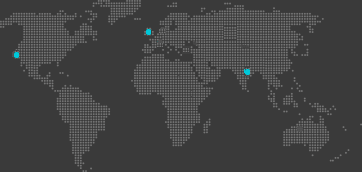Today more than half the world uses a smartphone, and almost two-thirds of the world’s population now has a mobile phone, as concluded by Digital in 2017 report (by Hootsuite and We Are Social). The ease of access to the internet (pervasive connectivity) and mobile-phone proliferation in almost every aspect of our lives has led to a digital landscape that involves machines, smart devices, and people interacting with another. The Internet of Things is an ecosystem of hardware, devices, smart objects, cloud computing, sensors, people, users, etc. IoT today has found use in different industry verticals. Whether it is the smartwatch that tracks your physical activity or your home’s smart thermostat, or a baby’s sleep monitoring system, or a smart trash can alerting a city’s official when it should be emptied, it’s all smart ecosystem around, all Internet of Things use cases. Here’s a little more detail about varied IoT applications and devices.
IoT and Human Body
Using Bluetooth, sensors, applications, portals, wearables, cloud computing and the human body, IoT powers applications that provide real-time information regarding health status and thereby, a person’s well being. Some of the popular applications are listed below:
- Using GPS on smartphones and other sensors like accelerometer, compass, video etc., a person’s every single movement, his location can be monitored on his smartphone.
- Parents can now sleep relaxedly as smart baby sleep monitors do the job of babysitting during infant nap times. Based on baby’s breathing patterns, body temperature, wake/sleep cycles and sleeping positions, the smart sleep monitor provides reports and alerts to the parents, all real-time. The parents can be anywhere, working or away from the baby, and they can now remotely watch their baby sleeping blissfully. This IoT application uses Bluetooth technology.
- FDA cleared a wearable sensor that can be worn by patients with risk of cardiac arrhythmias. This sensor monitors and sends information to the patient’s health care provider about his heart rate, breathing, physical activity, ECG. This way the patients do not have to visit the health care providers frequently, and for providers, it is useful to remotely track their medical condition..
- Family and other relevant well-wishers can now track an old-age home resident or their aging family member living with them or away from them. A wearable alarm in conjunction with sensors placed around the residence sends real-time information about the family member. This includes relaying information like physical activity, heart rate, sleep patterns, weight. Different parameters can be set as per a normal schedule, and whenever a deviation occurs, an alert is sent to the family members and caregivers.
- Ingestible sensors now provide information in a never-before way to health care providers regarding medicine effectiveness. The patient needs to wear a sensor patch, and ingests the pill, the pill after coming in contact with stomach fluids, sends information to the providers. This information enables the doctors to make informed decisions regarding continuation of the therapy or to eliminate it, and prescribe some other medication/treatment to the patient.
IoT and Government
- Smart waste management system like BigBelly is equipped with a sensor that sends alerts to municipal corporations when the trash bin needs to be emptied. This makes the use of resources like drivers, cleaners, fuel, and finances efficient. The cities can now be kept cleaner in a smart way.
- City government can now install sensors and with smartphone apps and cloud services, they can relay information as to empty parking spots. Citizens can now quickly find an empty spot, thereby reducing their fuel usage and minimizing traffic flows.
- Based on the season, weather, day conditions, time of the day/night, it can be calculated how much street light would be needed. City government can thus monitor energy usage as well as make decisions based on real-time information, thereby making optimum utilization of energy sources.
- The Air Quality Egg is the smart air quality monitor which gathers high-resolution readings of Nitrogen oxide and Carbon Monoxide in the air. This not only serves individuals but individuals after registering their egg, their data is automatically mapped. This provides a real-time source for location-specific, region-specific and in general global air quality.
IoT and Home
- With smart thermostats, users can remotely control the temperature of their home via smart devices like phone, tablets. These smart thermostats report users with their energy-consumption, learn their behavior and accordingly adjust themselves. This not only optimizes energy-usage but also reduces unnecessary spending on energy.
- Smart On/off outlets now allow people to turn on or off any plugged device, from anywhere in the world. This saves energy, money as well as generates reports about the power usage of a device.
- Easily misplaced or forgotten things like keys and cell phones can now be smartly found using Bluetooth tags.
- Users can now change their light style as well as switch it on or off with voice control or smart devices. These smart lights not only reduces electricity usage but can work based on user patterns and behavior.
- Gardening now does not need constant attention, because a suite of sensors combined with connectivity, gives real-time information about the plants if they need to be fertilized or need water.
IoT and Industries
- In the construction industry, the quality of concrete says a lot about the strength of the structure. With sensors embedded within foundation of the building, now the quality and strength of the structure can be known.
- Retailers can now try their A/B testing using smart retailing sensors which may detect which products bring the most engagement from customers, which layout of the store works the best, and based on these reports, how conversion can be improved.
- Wireless devices and sensors are now being used in Amazon forest to alert authorities about illegal deforestation. The trees under scrutiny are installed with this smart device, and once the tree which is being moved connects to the internet, its geographical coordinates are sent to the relevant authority.
As apparent from these varied implementations, IoT ecosystem is gaining momentum. The world is getting a bit smarter each day with pervasive connectivity, high mobile adoption, and IoT connecting machines to machines. But it should also be noted, with power comes huge responsibility.
IoT is making use of smart things but the biggest concerns arise from the security and privacy of huge amount of data generated by countless interactions between these smart machines, users, and networks. In the IoT system, the concept of traditional security doesn’t stand securely.
When manufacturers produce these devices, the important focus is on the functionality. Complete security at various levels or horizontal security is not in their plan. With IoT devices opening up several entry points for hackers and unauthorized access to data, for example related to people’s behavior, patterns, health, or industry specifics, it becomes imperative that something different, something comprehensive needs to be done to secure the IoT ecosystem. That’s what SmartAxiom plans to achieve. SmartAxiom provides Security-as-a-Service for the Internet of Things.
The IoT security solution proposed by SmartAxiom not only protects sensitive data but also maintains privacy and security in IoT networks, as well as offers some form of validation and consensus for transactions to prevent spoofing and theft. The solution is decentralized, unlike traditional client-server kind of security model. It’s based on Blockchain technology, thereby eliminating single points of failure, and creating a more resilient ecosystem for devices to run on. To learn more about SmartAxiom’s horizontal and decentralized IoT security solution, that will provide scalability, privacy, and reliability to the Internet of Things, contact our team today.




